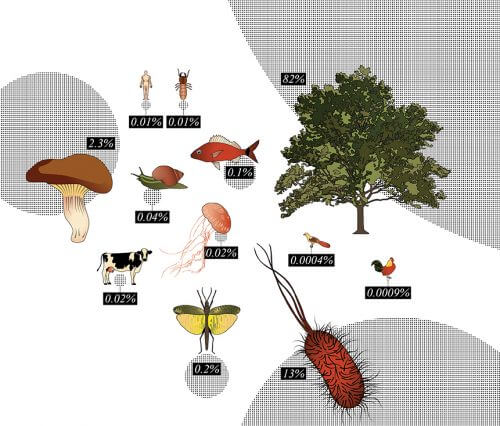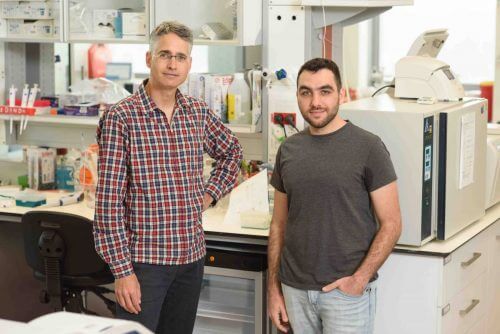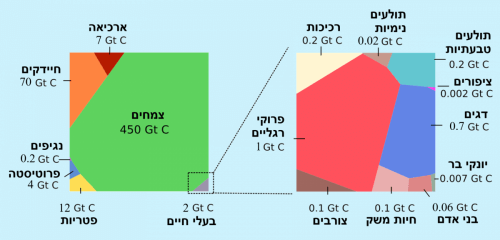What is there more in the world - bacteria, fungi or plants? Does life on Earth thrive more in the sea or on land? And what is the extent of humanity's influence on life in the world?

Which animals are the most common on earth? What is the prevalence of plants, for example, compared to fungi, bacteria or viruses? And what about the mass of all life in the oceans, compared to life on Earth? To answer these and many other questions, Weizmann Institute of Science scientists and their research partners compiled a global census, based on the total biomass of life on Earth. This research may help in understanding global phenomena such as the carbon cycle in nature or the extent of humanity's impact on the biosphere.
Research student Yanon Bar-On, from Prof. Ron Milo's research group in the Department of Plant and Environmental Sciences, began research through another project, in which he sought to compare certain proteins in different organisms, and examine their overall effect on the biosphere. He turned to the existing literature, but the numerical values he was looking for were not found. His search for this data led him to a two-year journey, during which he, Prof. Milo, and Prof. Rob Phillips from the California Institute of Technology, carried out a global biomass inventory, which allows, for the first time, to compare the biomass of bacteria with that of algae, termites, trees, Animals and humans - on a global scale. The study was published today in the scientific journal "Records of the American Academy of Sciences" (PNAS).
This project led us to corners of the world of biological research that I could not even imagine. We know that humans affect the biosphere, but now we can begin to quantify our impact."

"We turned to many experts and examined hundreds of articles to extract the information we needed regarding the distribution of the various groups," says Prof. Milo. And Bar-On adds: "This project led us to corners of the world of biological research that I could not even imagine. But first we had to get to the bottom of the various measurement and estimation methods, so that we could integrate them into our framework." Here a challenge awaited the researchers in the form of the certainty or uncertainty of numerical data. For example, satellite tracking makes it possible to carry out a fairly accurate study of the biomass of trees in the world, so the level of certainty of this figure is quite high. In contrast, the best estimates of the amount of bacteria living underground may be one order of magnitude away from their true value.
Understanding the relative estimates, even if some of them have a larger margin of error than others, allows you to see the "big picture" of biomass in the world. The biomass of the plant, for example, is the largest on the planet, much more than that of the bacteria, which were (erroneously) nicknamed the "hidden majority" in the past. And so, although the oceans cover a larger area on Earth, the biomass of terrestrial organisms is 10-100 times greater than that of marine organisms. Arthropods, a group that includes crustaceans, spiders and insects, are responsible for the largest part of the animal biomass, with the biomass of the fish group in second place. Animals that have a biomass close to that of all humans in the world - 0.06 gigatons of carbon - are the termites (it's important to remember: it's about mass, not a number of individuals).
Termites have a biomass close to that of all humans in the world - 0.06 gigatons of carbon

The study also offers an estimate of humanity's impact on biomass. According to this estimate, man has reduced the Earth's biomass to about half its original value. The biomass value of farm animals raised by humans is approximately 15 times greater than that of all land wild animals combined. "We know that humans affect the biosphere," says Prof. Milo, "but now we can begin to quantify (in numbers) our impact. Now we can add another layer of analysis to the issues of biodiversity and the 'ecological value' of different areas. In another direction, we can get a quantitative perspective that allows us to understand how much, for example, the death of trees in the Amazon region will affect the Earth's carbon cycle and the global climate."
Plants now make up more than 80% of the mass of life on Earth with about 450 gigatons of carbon. Bacteria settle for second place with 70 gigatons of carbon, which make up about 13% of the Earth's biomass.
#Science_Numbers28

3 תגובות
An interesting interview with the professor who led the research was published a few days ago in the first source:
https://www.makorrishon.co.il/magazine/dyukan/49957/
Important, groundbreaking and interesting research.
It's a shame it wasn't expanded on the subject - what the findings mean, the impact of humans, the impact of climate change, what the future holds, etc.